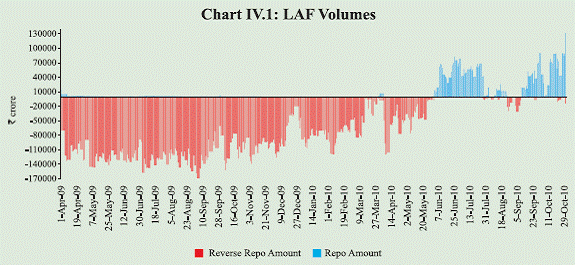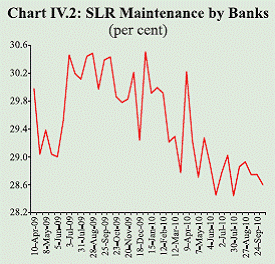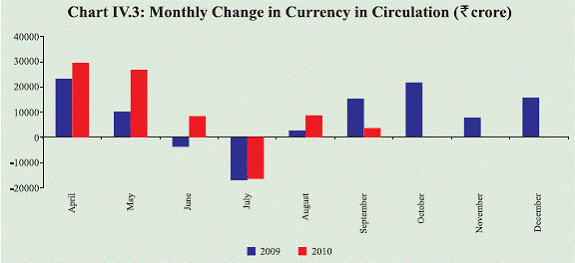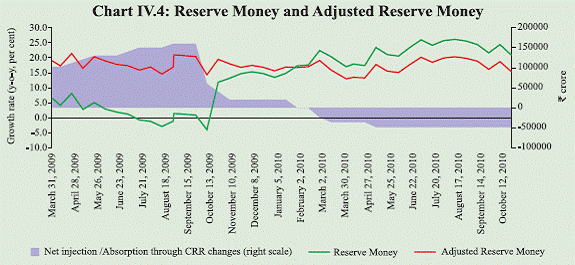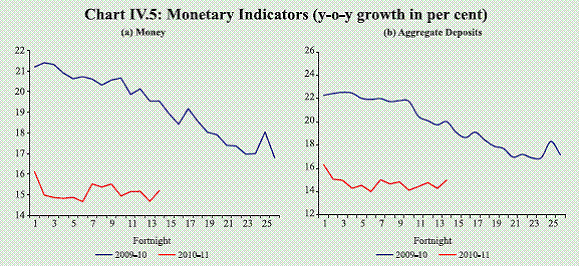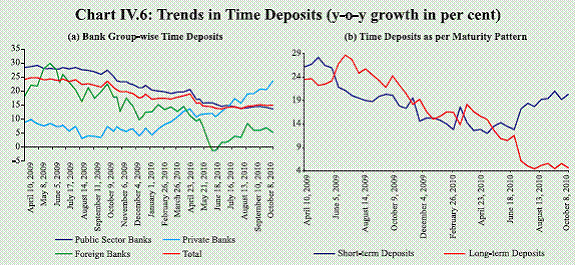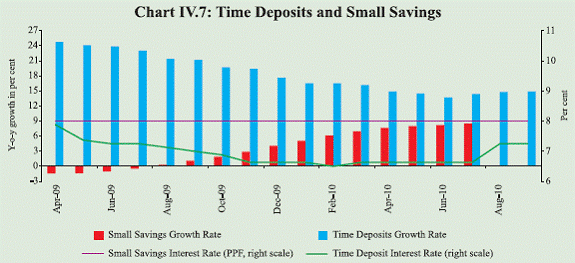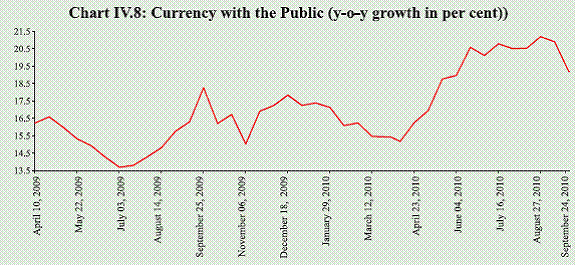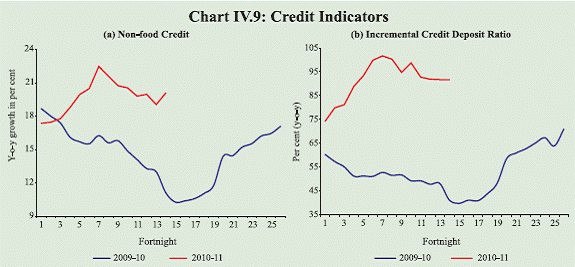 IST,
IST,
IV. Monetary and liquidity Conditions
The liquidity conditions, which transited from surplus to deficit in the wake of 3G/BWA auctions in May 2010, have generally remained in the deficit mode since then, reflecting the stance of monetary policy. Normalisation of policy rates, along with narrowing of the LAF corridor, and the shift from surplus to deficit liquidity conditions have resulted in an effective increase in the policy rate by 275 basis points since March 2010. Even as reserve money has grown at a fairly rapid pace, broad money (M3) growth continues to remain relatively subdued, reflecting the decelerated growth in aggregate deposits. With persistent deficit liquidity conditions, banks have started to scale up their deposit mobilisation efforts, as reflected in the higher deposit interest rates being offered since July 2010. IV.1 The non-disruptive normalisation of the monetary policy has significantly altered the liquidity and interest rate conditions over a few months. With repo emerging as the normal mode under the liquidity adjustment facility (LAF), and the consequent effective increase in the policy rate by 275 basis points, the transmission of monetary policy has also witnessed signs of strengthening. Since March 2010, the Reserve Bank has raised repo and reverse repo rates by 125 basis points and 175 basis points, respectively, which narrowed the LAF corridor from 150 basis points to 100 basis points. With continued build-up of government cash balances and increase in currency with the public, the LAF operations have remained mostly in deficit (injection) mode since June 2010. IV.2 During the first quarter of the year, non-food credit growth of scheduled commercial banks (SCBs) exceeded the indicative trajectory set out in the Monetary Policy Statement for 2010-11. Notwithstanding the one-off increase in credit demand associated with payment for telecom spectrums, the growth of non-food credit during the second quarter remained close to the Reserve Bank’s indicative projection. Money supply (M3) growth, which had started picking up from July 2010 registered deceleration towards the end of the quarter and showed acceleration for the latest fortnight for which data are available. The subdued growth in M3 has been largely conditioned by the decelerated growth in deposits, which account for over 85 per cent of money supply. On the sources side, there has been a considerable dip in the rate of growth of banking system’s credit to the government (Table IV.1). Liquidity Management IV.3 During 2010-11 so far, the centre’s surplus balance with the Reserve Bank has been a key driver of autonomous liquidity. Currency with the public, which registered high growth during the year so far, has been another key determinant of autonomous liquidity. The LAF window of the Reserve Bank, which remained in surplus mode for nearly 18 months, switched into deficit mode towards end- May 2010 and largely maintained the trend subsequently (Chart IV.1).
IV.4 With the persistence of deficit liquidity conditions, the Reserve Bank extended the liquidity-easing measures introduced in May 2010, i.e., allowing SCBs to avail additional liquidity support under the LAF to the extent of up to 0.5 per cent of their NDTL till mid-July and operation of second LAF (SLAF) on a daily basis till end-July 2010. The average daily liquidity injection under the LAF was around `47,000 crore during July 2010. In view of the evolving inflationary scenario, the repo and the reverse repo rates were raised by 50 basis points and 75 basis points, respectively, in two stages in July 2010 (Table IV.2).
IV.5 The liquidity conditions improved in August 2010, mainly on account of large pre-scheduled public debt redemptions towards end-July 2010, and the average daily net injection of liquidity declined to around `1,000 crore during the month. After a brief period of surplus liquidity (from end- August to early-September 2010), the liquidity conditions again switched to deficit mode as liquidity migrated to government balances with the Reserve Bank on account of quarterly advance tax payments. IV.6 On the basis of the assessment of the macroeconomic situation, the Reserve Bank increased the repo rate and reverse repo rate by 25 basis points and 50 basis points, respectively, in the mid-quarter monetary policy review in September. The liquidity conditions remained in deficit mode in the second half of September 2010 as the cash balances of the centre started building-up, and the average daily net liquidity injection was around `24,000 crore during the month.The liquidity conditions tightened further in October 2010. In order to ease the frictional liquidity pressure, the Reserve Bank announced certain temporary measures,viz., conduct of SLAF on October 29 and November 1, 2010, conduct of a special two-day repo auction under LAF on October 30, 2010 and waiver of penal interest on shortfall in maintainance of SLR on October 30-31, 2010, to the extent of 1 per cent of NDTL for availing additional liquidity support under LAF.
IV.7 Despite surplus government balance and currency with the public operating as the major drains on liquidity during the second quarter of 2010-11, when compared with the situation prevailing at the end of the first quarter, variations in both currency and government surplus had a positive contribution to autonomous liquidity in the system (Table IV.3). The liquidity situation was managed primarily through LAF (Table IV.4).
IV.8 There has been a significant reduction in the holdings of government securities by SCBs not only because of the higher growth of non-food credit, but also because banks tapped the repo window under the LAF for their liquidity needs, leading to gradual decline in SLR maintenance (Chart IV.2). The excess SLR investments of SCBs amounted to `1,86,097 crore in early October 2010 compared with `2,80,645 crore a year ago. With moderation in excess SLR, banks are making efforts to increase their deposit base as well as modulating the excess reserves maintained by them with the Reserve Bank.
Reserve Money IV.9 Unlike the first quarter when the main component of increase in reserve money was currency in circulation, the reserve money growth in the second quarter was led by increase in banks’ deposits with Reserve Bank (Table IV.5). Banks’ deposits with the Reserve Bank increased in line with the increase in their net demand and time liabilities. On average, banks maintained excess reserves of `5,200 crore with the Reserve Bank during the quarter. Even though currency has shown strong y-o-y growth so far, the contraction during the quarter under review is consonant with the trend of subdued currency demand during the second quarter of the year (Chart IV.3).
IV.10 On the sources side, the Reserve Bank’s credit to the Centre declined during the quarter, due to the combined effect of decline in the quantum of repo operations under the LAF1 as compared to the previous quarter and build up of government balances. IV.11 The adjusted reserve money (base money adjusted for the first round impact of monetary policy actions of the Reserve Bank in the form of CRR changes) increased by 15.9 per cent (y-o-y) as on October 22, 2010 reflecting the impact of increase in currency in circulation (on the components side) and Reserve Bank credit to the government (on the sources side) (Chart IV.4).
Money Supply IV.12 The deceleration in the growth of broad money (M3), that started in 2009-10, continued in the first quarter of 2010-11. Even though there was some revival in the growth rate of M3 during the second quarter, it still remained below the trajectory of 17 per cent indicated in the Monetary Policy Statement 2010-11 (Chart IV.5 a). The pattern of growth in M3 mainly tracked the behaviour of the major component of money stock, i.e., aggregate deposits (Chart IV.5 b).
IV.13 Since time deposits are the major constituent of aggregate deposits (around 87 per cent), a deceleration in these deposits is reflected in the aggregate deposits as well. A disaggregated analysis of the bank group-wise data suggests that the behaviour of time deposits replicates the deposit pattern of public sector banks, as they account for a predominant share of time deposits. Foreign banks witnessed a sharp deceleration in time deposit growth rate in the recent period, while the private sector banks have bucked the overall trend, with a sharp acceleration in their time deposits (Chart IV.6 a). Further analysis suggests that long-term time deposits (maturity more than one year) witnessed a sharper deceleration (Chart IV.6 b).
IV.14 The growth rate of time deposits has, however, shown a moderate pick-up since July 2010 in the wake of efforts made by banks for mobilisation of deposits. Also, there has been an increased inflow into small savings schemes since August 2009 as small savings have yielded higher returns than time deposits with banks since the beginning of 2009-10 (Chart IV.7). Total incremental inflows into small savings are, however, only a small fraction of monthly increases in time deposits. IV.15 Given the low opportunity cost of holding money in an environment of high inflation and depressed deposit interest rates, the demand for currency exhibited acceleration in growth during recent period (Chart IV.8). The increase in currency with the public is also reflective of increased asset prices and payment under schemes such as the MGNREGA. The increase in the cash component of economic transactions indicates the need for furthering financial inclusion. The increased currency demand and hence the currency deposit ratio as well as the 100 basis points increase in the CRR since February 2010, led to some decline in the money multiplier during the first half of the year. Money growth, thus, remains subdued relative to the higher rate of increase seen in reserve money.
IV.16 On a quarterly basis, the bulk of the increase in money stock during the second quarter of 2010-11 was owing to an increase in time deposits. (Table IV.6). Given the excess liquidity that prevailed in the system till end-May 2010, banks were not actively mobilising deposits. The transmission of the monetary tightening measures initiated by the Reserve Bank since February 2010 to the deposit interest rates has started to become visible only since July 2010 (Chapter V, Table V.7). IV.17 As regards sources of M3, the increase in money supply during the second quarter came mainly from banking system’s credit to the commercial sector. There was a major pick-up in the growth of non-food credit extended by SCBs during the first quarter of 2010-11 as telecom companies raised credit to pay for the 3G and wireless access spectrums (Chart IV.9 a). Credit flow during the second quarter has shown a slight moderation but largely remained above or close to the indicative trajectory of 20 per cent growth set out in the First Quarter Review of Monetary Policy (July 2010). Reflecting this moderation, as well as the improved deposit mobilisation since July 2010, the incremental non-food credit deposit ratio of SCBs fell below the peak of over 100 per cent attained towards the end of the first quarter and the beginning of the second quarter (Chart IV.9 b).
IV.18 The momentum in credit growth was seen across all bank groups, with private banks showing the highest growth rate at the beginning of the third quarter of 2010-11 (Table IV.7). Public sector banks accounted for 74 per cent of the incremental credit off take on a year-onyear basis as at the beginning of October 2010. Though the pace of deposit growth for SCBs as a whole remains lower than last year, banks have increased their borrowings from overseas as well as from financial institutions. These alternative funds have supported a higher credit growth, as investment in government and other approved securities, non-SLR securities as well as foreign currency assets has exhibited deceleration or contraction in y-o-y growth (Table IV.8). IV.19 Data on sectoral deployment of gross bank credit show significant improvement in credit flow to industry, services and personal loans during the current financial year, while credit to agriculture has declined further (Table IV.9). A look at the disaggregated data, however, suggests that the credit flow to industry is not yet broad-based as the growth is mainly driven by flow of credit to the infrastructure sub-sector, iron and steel, chemicals and chemical products, other metal and metal products and engineering industries.
IV.20 Overall flow of resources from the financial sector to the commercial sector increased significantly in the first half of 2010-11 relative to the flows in the corresponding period of last year (Table IV.10). While domestic non-bank sources of funds declined compared to the corresponding period last year, funding from foreign sources increased on account of higher amounts raised in the form of short-term credit and through ECBs and ADRs/GDRs. Reflecting the pick-up in demand for credit, incremental non-food credit (adjusted) exceeded the flows from non-banking sources. IV.21 Overall, the liquidity conditions have changed consistent with the objective of calibrated normalisation of monetary policy. Net liquidity switched to deficit mode towards the end of May 2010 after eighteen months of surplus, and has largely remained so since then. Reflecting the strengthening demand for finance consistent with robust economic growth, credit growth has picked up. Even though broad money growth remains below the trajectory envisaged in the Monetary Policy Statement for 2010-11, there has been an improvement since July 2010. With banks expected to scale up their deposit mobilisation to meet the demand for credit, broad money growth could be expected to rise. With liquidity in deficit mode and as deposit and lending rates start to move up further with some lag, the transmission of monetary policy could further strengthen.
1 The Reserve Bank's credit to the Centre is affected by LAF operations, OMO, MSS balances and government's cash surplus with the Reserve Bank. Increase in repo/OMO purchases and decline in reverse repo/MSS balances/Government's surplus balances with Reserve Bank lead to increase in net Reserve Bank credit to the Centre, and vice versa. |
|||||||||||||||||||||||||||||||||||||||||||||||||||||||||||||||||||||||||||||||||||||||||||||||||||||||||||||||||||||||||||||||||||||||||||||||||||||||||||||||||||||||||||||||||||||||||||||||||||||||||||||||||||||||||||||||||||||||||||||||||||||||||||||||||||||||||||||||||||||||||||||||||||||||||||||||||||||||||||||||||||||||||||||||||||||||||||||||||||||||||||||||||||||||||||||||||||||||||||||||||||||||||||||||||||||||||||||||||||||||||||||||||||||||||||||||||||||||||||||||||||||||||||||||||||||||||||||||||||||||||||||||||||||||||||||||||||||||||||||||||||||||||||||||||||||||||||||||||||||||||||||||||||||||||||||||||||||||||||||||||||||||||||||||||||||||||||||||||||||||||||||||||||||||||||||||||||||||||||||||||||||||||||||||||||||||||||||||||||||||||||||||||||||||||||||||||||||||||||||||||||||||||||||||||||||||||||||||||||||||||||||||||||||||||||||||||||||||||||||||||||||||||||||||||||||||||||||||||||||||||||||||||||||||||||||||||||||||||||||||||||||||||||||||||||||||||||||||||||||||







